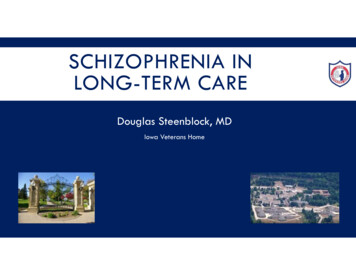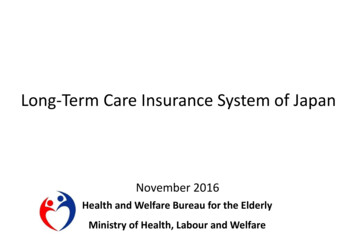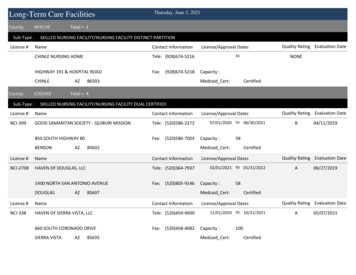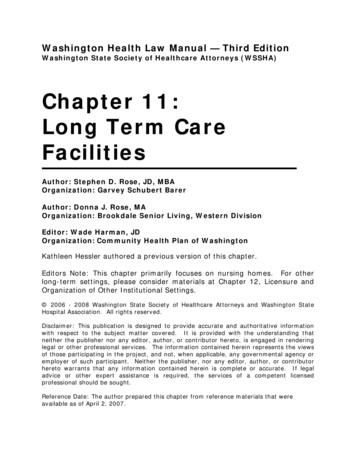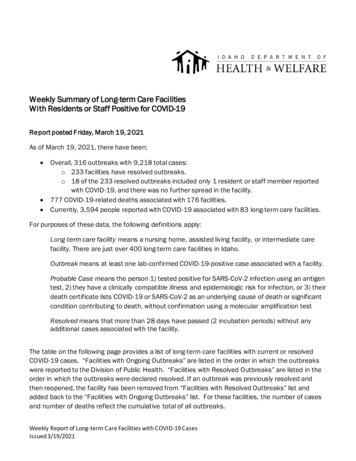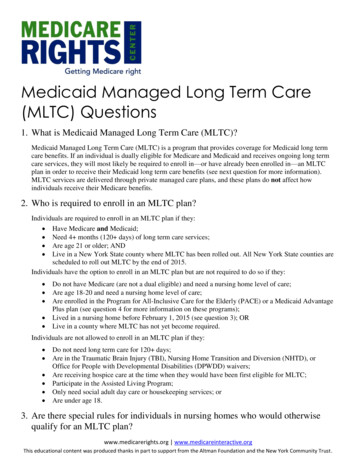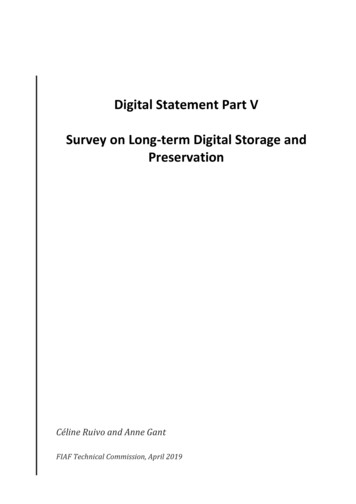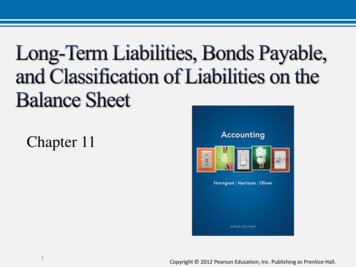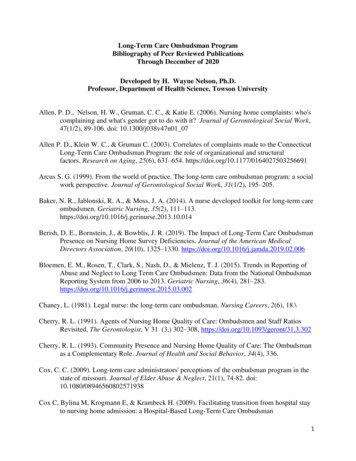
Transcription
Long-Term Care Ombudsman ProgramBibliography of Peer Reviewed PublicationsThrough December of 2020Developed by H. Wayne Nelson, Ph.D.Professor, Department of Health Science, Towson UniversityAllen, P. D., Nelson, H. W., Gruman, C. C., & Katie E. (2006). Nursing home complaints: who'scomplaining and what's gender got to do with it? Journal of Gerontological Social Work,47(1/2), 89-106. doi: 10.1300/j038v47n01 07Allen P. D., Klein W. C., & Gruman C. (2003). Correlates of complaints made to the ConnecticutLong-Term Care Ombudsman Program: the role of organizational and structuralfactors. Research on Aging, 25(6), 631–654. https://doi.org/10.1177/0164027503256691Arcus S. G. (1999). From the world of practice. The long-term care ombudsman program: a socialwork perspective. Journal of Gerontological Social Work, 31(1/2), 195–205.Baker, N. R., Jablonski, R. A., & Moss, J. A. (2014). A nurse developed toolkit for long-term careombudsmen. Geriatric Nursing, 35(2), .10.014Berish, D. E., Bornstein, J., & Bowblis, J. R. (2019). The Impact of Long-Term Care OmbudsmanPresence on Nursing Home Survey Deficiencies. Journal of the American MedicalDirectors Association, 20(10), 1325–1330. , E. M., Rosen, T., Clark, S., Nash, D., & Mielenz, T. J. (2015). Trends in Reporting ofAbuse and Neglect to Long Term Care Ombudsmen: Data from the National OmbudsmanReporting System from 2006 to 2013. Geriatric Nursing, 36(4), .03.002Chaney, L. (1981). Legal nurse: the long-term care ombudsman. Nursing Careers, 2(6), 18.\Cherry, R. L. (1991). Agents of Nursing Home Quality of Care: Ombudsmen and Staff RatiosRevisited, The Gerontologist, V 31 (3,) 302–308, https://doi.org/10.1093/geront/31.3.302Cherry, R. L. (1993). Community Presence and Nursing Home Quality of Care: The Ombudsmanas a Complementary Role. Journal of Health and Social Behavior, 34(4), 336.Cox, C. C. (2009). Long-term care administrators' perceptions of the ombudsman program in thestate of missouri. Journal of Elder Abuse & Neglect, 21(1), 74-82. doi:10.1080/08946560802571938Cox C, Bylina M, Krogmann E, & Krambeck H. (2009). Facilitating transition from hospital stayto nursing home admission: a Hospital-Based Long-Term Care Ombudsman1
Program. Journal of Gerontological Social Work, 52(8), 1Cox, C. C., Eldridge-Houser, J., Hasken, J., & Temme, M. (2011). Relationship of facilitycharacteristics and presence of an ombudsman to Missouri long-term care facility stateinspection report results. Journal of Elder Abuse & Neglect, 2393, 273-288. doi:10.1080/08946566.2011.584051Delany, C. A., & Davies, K. A. (1977). Coming to grips with gripes: the nursing homeombudsman. Journal - American Health Care Association, 3(6), 6–14.Estes, C. L., Lohrer, S. P., Goldberg, S., Grossman, B. R., Nelson, Koren, M. J., & Hollister, B.(2010). Factors associated with perceived effectiveness of local long-term careombudsman programs in New York and California. Journal of Aging & Health, 22(6),772-803. doi: 10.1177/0898264310366737Estes, C. L., Zulman, D. M., Goldberg, S. C., & Ogawa, D. D. (2004). State long term careombudsman programs: factors associated with perceived effectiveness. Gerontologist,44(1), 104-115. doi: 10.1039/geront/44.1.104Fasano M. A. (1980). The long term care ombudsman. Journal of Gerontological Nursing, 6,717–720.Filinson, R. (2001). Evaluation of the impact of a volunteer ombudsman program: the RhodeIsland experience. Journal of Elder Abuse & Neglect, 13(4), 1-20. doi:10.1300/j095v13n04 1Forman, A. (1974). The Nursing Home Ombudsman Demonstration Program. Health ServicesReports, 89(2), 128. https://doi.org/10.2307/4595000Freeman, I. C. (2000). Uneasy Allies: Nursing Home Regulators and ConsumerAdvocates. Journal of Aging & Social Policy, 11(2/3), 127. 00/J031v11n02 14Full M., B. F., Strobel, D. M., Leung, Y., Court, M. W., Morris, J. R., May, G., Reeves, S.,Davies, M., Cartan, H., & Philyaw, M. L. (2010).Changing systems to address elderabuse: examples from aging services, the courts, the long-term care ombudsman, andthe faith community. Journal of Elder Abuse & Neglect, 22(3/4), 306-327. doi:10.1080/08946566.2010.490159Gubrium. J. F. (1984). Resolving Grievances in the Nursing Home: A Study of the OmbudsmanProgram Abraham Monk Lenard W. Kaye Howard Litwin. Contemporary Sociology, 13(4),433.Henderson, J. N., Mason, L. D., & Vesperi, M. D. (1995). Ethnography and the nursing homeombudsman. Culture of Long Term Care: Nursing Home Ethnography, 71-92.2
Hollister, B. A., & Estes, C. L. (2013). Local Long-Term Care Ombudsman ProgramEffectiveness and the Measurement of Program Resources. Journal of AppliedGerontology, 32(6), 708–728. https://doi.org/10.1177/0733464811434144Hosay, C. K. (2003). State long-term care ombudsman knowledge of state laws concerningnursing home conscience policies. Illness, Crisis & Loss, 11(4), 305-317. doi: 101177/1054137303256519Huber, R. (2000). Interpreting the meaning of ombudsman data across states: the criticalanalyst-practitioner link. Journal of Applied Gerontology, 19(1), 3-17. doi:10.1177/073346480001900101Huber, R., Borders, K. W., Badrak, K., Netting, F. E., & Nelson, H. W. (2001). Nationalstandards for the long-term care ombudsman program and a tool to assess compliance:the Huber Badrak Borders scales. Gerontologist, 41 (2), 264-272. doi:10.1093/geront/41.2.264Huber, R., Borders, K. Netting, F.E, & Nelson, H.W. (2001). Data from long-term careombudsman programs in six states: the implications of collecting residentdemographics. Gerontologist, 41(1), 61-69. doi: 10.1093/geront/41.1.61Huber, R. Netting, F. E., & Paton, R. N. (1993). In search of the impact of staff mix on longterm care ombudsman programs. Nonprofit & Voluntary Sector Quarterly, 22(1), 69-92.doi: 10.1177/089976409302200106Jogerst G, Daly J, & Hartz A. (2005). Ombudsman program characteristics related to nursinghome abuse reporting. Journal of Gerontological Social Work, 46(1), 85–98.Kaluzny, A. (2010). The Patient Care Ombudsman: Who Should It Be? Elder LawJournal, 17(2), 343–373.Keith, P. M. (2003). Interests and skills of volunteers in an ombudsman program: opportunitiesfor participation. International Journal of Aging & Human Development, 57 (1), 1-20.doi: 10.2190/UXA7-0EE5-3WJ7-BLYLKeith, P. M. (2006). Nursing home administrators’ attribution of anti-facility bias toombudsman programs. Journal of Applied Gerontology, 25 (2), 120-136. doi:10.1177/0733464805285250Keith, P. M. (2008). Nursing home administrators’ views of their own and volunteer residentadvocates’ enhancement of the long-term care. Journal of Abuse and Neglect, 17(1), 7587. doi: 10.1300/J084v17v01 05Keith, P. M. (2005). Nursing home administrators’ views of volunteers’ work in an ombudsmanprogram. Journal of Aging Studies, 19(4), 513–520. 16/j.jaging.2004.09.0023
Keith, P. M., & Schafer, R. B. (2002). Expected and actual difficulties of volunteer residentadvocates in an ombudsman program. Journal of Applied Gerontology, 21(4), 421436. doi: 10.1177/073346402237630Keith, P. M. (2001). Support from others and efficacy of volunteer ombudsmen in long-term carefacilities. International Journal of Aging & Human Development, 52 (4), 297-311. doi:10.2190/XHKC-JT3D-TFH-WTTBKeith, P. M. (2010). Training and educational activities, efficacy, and worry among volunteerombudsmen in nursing facilities. Educational Gerontology, 26(3), 249- 260. doi:101080/036012700267231Magruder, K. J., Fields, N. L., & Xu, L. (2019). Abuse, neglect and exploitation in assistedliving: an examination of long-term care ombudsman complaint data. Journal of ElderAbuse & Neglect, 31(3), 209–224. der, K. J., Fields, N. L., & Xu, L. (2018). Sizing up assisted living: an examination oflong-term care ombudsman complaint data. Home Health Care ServicesQuarterly, 37(3), 158–176. , B. F., Strobel, D. M., Leung, Y., Court, M. W., Morris, J. R., May, G., Reeves, S., Davies,M., Cartan, H., & Philyaw, M. L. (2010). Changing systems to address elder abuse:examples from aging services, the courts, the long-term care ombudsman, and the faithcommunity. Journal of Elder Abuse & Neglect, 22(3), 306-327. doi:10.1080/08946566.2010.490159Monk, A., & Kaye, L. W. (1982). Assessing the efficacy of ombudsman services for the aged inlong term care institutions. Evaluation and Program Planning, 5(4), 363–370.Ostwald, S. K., Runge, A., Lees, E. J., & Patterson, G. D. (2003). Texas Certified VolunteerLong-Term Care Ombudsmen: Perspectives of Role and Effectiveness. Journal of theAmerican Medical Directors Association, 4(6), 323–328. 16/S1525-8610(04)70392-8Persson, D. (2002). The Ombudsman Program: An Overview of the History, Purpose, and Role ofOmbudsmen in Long-Term Care Facilities. Journal of the American Medical 04)704922Nelson, H. W. (1995). Long-term care volunteer roles on trial: ombudsman effectivenessrevisited. Journal of Gerontological Social Work, 23(3/4), 25-46. doi:10.1300J038V23N03 03Nelson. HW. INJUSTICE AND CONFLICT IN NURSING HOMES: Toward Advocacy andExchange. Journal of Aging Studies. 2000;14(1):39. doi:10.1016/S0890-4065(00)80015-8Nelson, H. W., Agley, D., Netting, F. E., Borders, K. W., & Huber, R. (2013). State Long-TermCare Ombudsmen’s Perceptions of Their Program’s Disaster Preparedness Roles and4
Readiness. Journal of Applied Gerontology, 32(8), Nelson, H. W., Hooker, K., DeHart, K. N., Edwards, J. A., & Lanning, K. (2004). Factorsimportant to success in the volunteer long-term care ombudsman role. Gerontologist, 44(1),116-120. doi: 10.1039/geront/44.1.116Nelson, H. W., Huber, R., Netting, F. E., & Borders, W. (2004). Factors effecting volunteerombudsman effort and service duration: comparing active and resigned volunteers. Journalof Applied Gerontology, 23(3), 309-323. doi: 10.1177/0733464804267581Nelson, H. W., Huber, R., & Walter, K. L. (1995). The relation of volunteer long-term careombudsmen to regulatory nursing home actions. The Gerontologist, 35(4), 509-514. doi:10.1093/geront/35.4.509Nelson, H.W., Netting, F. E., Borders, K., Huber, R. & Agley, D. (2011). Former volunteer reporton the most meaningful factors affecting their service with the Oregon Long Term CareOmbudsman Program. International Journal of Volunteer Administration. 27(3), 10-19.Nelson, H. W., Netting, F. E., Borders, K., & Huber, R. (2004) Volunteer attrition: Lessons learned fromOregon’s long-term care ombudsman program. Journal of Volunteer Administration. , 22, (4). 2833.Nelson, H. W., Netting, F. E., Huber, R., & Borders, K. (2003). External grievances againstvolunteer advocates: expecting, investigating, and managing complaints. Journal ofVolunteer Administration, 21(4), 10-16.Nelson, H. W., Netting, F. E., Huber, R., & Borders, K. (2002). Training nursing home patients’rights case advocates effective conflict skills. Gerontology and Geriatric Education, 22(2),29-42. doi: 10.1300/J021v22n02 3Nelson, H. W., Netting, F. E., Huber, R., & Borders, K. (2001). The ombudsman social workeralliance: using a resident centered model of situational conflict tactics. Journal ofGerontological Social Work, 35(3), 65-82. doi: 10.1300/J083v35n03 06Nelson, H. W., Huber, R., & Walter, K. L. (1995). The relation of volunteer long-term careombudsmen to regulatory nursing home actions. The Gerontologist, 35(4), 509-514. doi:10.1093/geront/35.4.509Nelson, H. W., Pratt, C., Carpenter, C. E., & Walter, K. L. (1995). Factors affecting volunteerlong-term care ombudsman organizational commitment and burnout. Nonprofit andVoluntary Sector Quarterly, 24(3), 213-231. doi: 10.1177/089976408502400303Nelson, H. Wayne, Yang, B. K., Ellen Netting, F., & Monahan, E. (2020). Community LongTerm Care Ombudsman Program Disaster Assistance: Ready, Willing orAble? Journal of Homeland Security & Emergency Management, 17(2), du/10.1515/jhsem-2019-00155
Netting, F. E., Huber, R., & Patton, R. N. (1995). Elder rights and the long-term careombudsman program. Social Work, 40(3), 351-357. doi: 10.1093/sw/40.3.351Netting, F. E., & Paton, R. N. (1992). The long-term care ombudsman program: what does thecomplaint reporting system tell us? Gerontologist, 32(6), 843-849.doi:10.1093/eront/32.6.843Netting, F. E., Huber, R., Paton, R.N., & Kautz, R. (1995). Elder rights and the long-termcare ombudsman program. Social Work, 40(3), 351-357. doi: 10.1093/sw/40.3.351Netting, F. E., Huber, R., Borders, K., Kautz, J. R., & Nelson, H. W. (2000). Volunteer and paidombudsmen investigating complaints in six states: a natural triaging. Nonprofit& Voluntary Sector Quarterly, 29(3), 419-438. doi: 10.1177/0899764000293004Netting, F. E., & Nelson, H. W. (2020). Managing Disaster Preparation amid Conflicts ofInterest: A Teaching/Learning Case Study. Human Service Organizations:Management, Leadership & Governance, 44(2), 187–197. 80/23303131.2019.1707733Netting, F. E., Nelson, H. W., Borders, K., & Huber, R. (2004). Volunteers and paid staffrelationships: implications for social work administration. Administration in SocialWork, 28(3/4), 69-89. doi: 10.130/J147v28n0304Perssons, D. I. (2004). Volunteer ombudsmen in the nursing home: obstacles to retention.Journal of Applied Gerontology, 25(2), 120-136. doi: 10.1016j.jaging.2004.01.003Persson, D. (2002). The Ombudsman Program: An Overview of the History, Purpose, and Roleof Ombudsmen in Long-Term Care Facilities. Journal of the American MedicalDirectors Association, 3(4), 270–273. ey, G. K., Castro, C., & Cron, S. G. (2015). Utilizing online tools to increase volunteerombudsmen presence in long-term care. Geriatric Nursing, 36(1), 1.001Skelley-Walley, J. E. (1995). An ombudsman perspective. Journal of Elder Abuse & Neglect,1(1), 89-206. doi: 10.1300/J084v07n02 06Thacker, E. L. (2006). The United States Long-Term Care Ombudsman Program: understandingthe real-life circumstances underlying resident complaint data. Expert Review ofPharmacoeconomics & Outcomes Research, 6(6), Troyer, J. L., & Sause, W. (2013). Association between Traditional Nursing Home QualityMeasures and Two Sources of Nursing Home Complaints. Health Services Research, 48(4),1256–1278. https://doi.org/10.1111/1475-6773.120216
Watson, M. (1993). Elder abuse in long-term care environments: a pilot study using informationfrom long-term care ombudsman reports in one California county. Journal of ElderAbuse & Neglect, 95-112. doi: 10.1300/J084v05n04 07Wisconsin nursing home ombudsman program shows scoreboard on complaints.(1976). Employee Benefit Plan Review, 30(7), 30.Whitford, A. B., & Yates, J. (2002). Volunteerism and social capital in policyimplementation: evidence from the long-term care ombudsman program. Journal ofAging & Social Policy, 14(3/4), 61-74. doi: 10.1300/J031v14n03 04Ziminski, C. E. (2011). Elder Abuse and Neglect Investigation in California Long TermCare Facilities. On the Edge, 17(3), 1.Academic Books, Book Chapters, Encyclopedia EntriesBentrott, M.D. (2015). Long-Term Care Ombudsmen. The Encyclopedia of Adulthood andAging, 1-4. doi:10.1002/9781118521373.wbeaa121Ducayet, P.H. & Laubert, B.L. (2016). Long-Term Care Ombudsman Program. In D.B.Kaplan, B. Berkman, D.B. Kaplan, B. Berkman (Eds). The Oxford Handbooks ofSocial Work in Health and Aging, 2nd ed (pp. 269-278). New York, NY, US:Oxford University Press.Monk, A., Kaye, L. W., & Litwin, H. (1984). Resolving grievances in the nursing home: astudy of the ombudsman program. Columbia University PresHuber, R., Nelson, H.W., Netting, F.E., Borders, K. (2007). Elder Advocacy: Essential Practice and SkillsAcross Settings. Belmont, CA: Thompson: Brooks Cole.Netting, F. E., Borders, K. Nelson, H. W., & Huber, R. (2011). The Long-Term Care Ombudsman Program:The Potential of Accessible Secondary Databases for Empirically Based Community andOrganizational Change. (pp. 63-80). By Maria Roberts-DeGennaro and Sondra Fogel, (Eds). UsingEvidence to Inform Practice for Community and Organizational Change. Lyceum BooksNetting, F. E., Nelson, H. W., Huber, R. H., & Borders, K. (2006). Long term care ombudsman program,(pp. 692-695). In the Encyclopedia of Aging (4th ed). Richard Schulz, Linda S. Noelker, KennethRockwood, Richard L. Sprott (Eds). New York:NY Springer Publishing Co.7
Long-Term Care Ombudsman Program Bibliography of Peer Reviewed Publications Through December of 2020 Developed by H. Wayne Nelson, Ph.D. Professor, Department of Health Science, Towson University Allen, P. D., Nelson, H. W., Gruman, C. C., & Katie E. (2006). Nursing home complaints: who's complaining and what's gender got to do with it?

